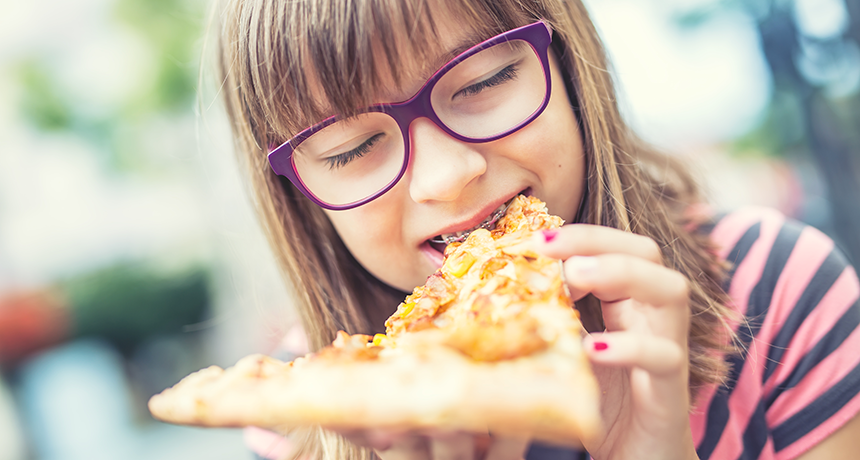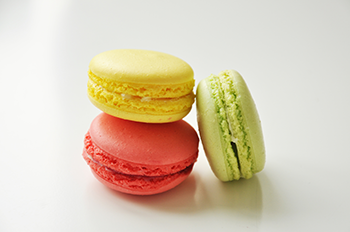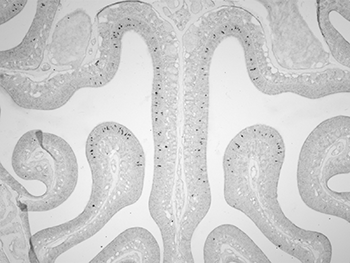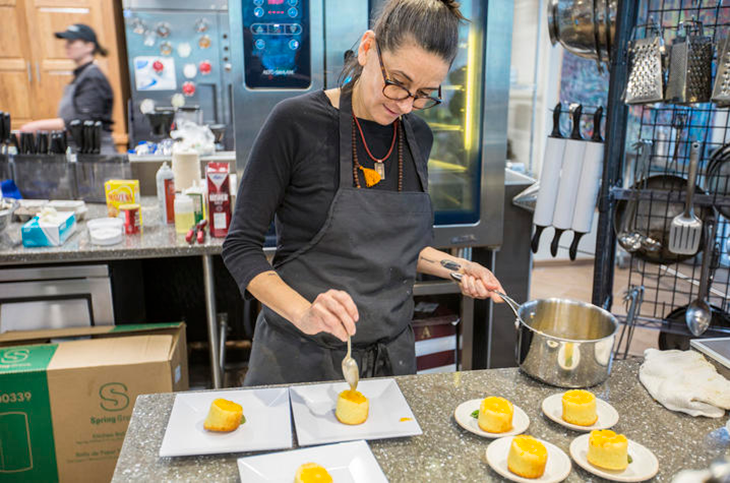Taste good? Senses inform the brain — but don’t tell everyone the same thing
By mapping how the body determines flavor, scientists reveal clues that could help people eat better

All our senses inform what we taste.
MarianVejcik/iStockphoto
By Lela Nargi
Food Network host Andrew Zimmern once asked Taria Camerino: “What do I taste like?” It’s a strange question. But not for Camerino. This Atlanta-based chef is one of many people who sense their world in special ways.
Camerino was born with synesthesia (Sin-uhs-THEE-zhah). That means her senses are tangled up with one another. (The term comes from the Greek words syn, meaning together, and aesthesis, meaning sensation.)
Some synesthetes see each letter of the alphabet in a particular color. Others see shapes when they hear music. Camerino’s brain links things she sees and hears to flavors. That’s how she could answer Zimmern’s unusual question.
“I watched the way he moved,” she recalls, and discovered that he tasted like toasted prawn shells and bay-leaf syrup. Her unusual sensory ability lets her understand people through food. Sometimes, she uses this gift to aid people. Some illnesses dull their victims’ senses. With Camerino’s help, some who had lost much of their sense of taste regained “more connection to [it].”
Most people are not synesthetes. But everyone’s senses work together to process taste. Scientists are discovering how these connections affect what we eat. They’re also learning how tastes’ hidden meanings might lead to behaviors that might make people sick — or do the opposite: encourage healthier eating.

Tastes carry hidden meanings
For the most part, people process different sensations — taste, smell, hearing, touch and sight — in different parts of the brain’s cerebral (Seh-REE-brul) cortex. That’s its outermost layer. But all the senses talk to each other through neural networks. These are groups of interconnected brain cells, called neurons.
The signaling between these sensory cells lets us hear the crispy crunch of a potato chip and know it’s fresh. Or see a plump peach and think, “Yum, that looks sweet!” The information we get from this chatter helps us decide what to eat.

What and how we make those decisions interests Julie Mennella. She works at the Monell Chemical Senses Center in Philadelphia, Pa. As a biopsychologist (BY-oh-sy-KOL-oh-gist), she studies how behaviors can be affected by taste preferences that develop during infancy and early childhood.
Early in human history, the ability to recognize and respond to different tastes without thinking helped people survive. A sweet taste, explains Mennella, isn’t just pleasing. It also tells someone that a food is rich in calories. That’s important because calories provide the energy needed to fuel our bodies. A salty taste indicates that food contains salt — sodium chloride. It’s a mineral needed for bone health, especially when bones are growing during childhood.
Sour and bitter tastes also carry messages — negative ones that might cause you to spit a food out. A sour taste told our ancestors a food might be spoiled. A bitter taste might have meant a meal was poisonous.
You might enjoy eating sour fruits such as lemons or grapefruit, or bitter vegetables such as turnips or Brussels sprouts. But you probably learned to like their tastes over time.
Today, most of us don’t have to hunt or forage for food as our ancient ancestors did. We can find plenty of meat and fruit — and chips and cookies — at the supermarket. What scientists call our food environment has changed.
Our brains still give us cues that guide our food choices, though. And that can be a problem — especially for kids. Mennella found in a 2016 study that kids and teens prefer far sweeter tastes than do adults.
This preference can set kids on a lifelong path to unhealthy eating. A sweet tooth can lead to overeating — and obesity. It also ups the risk someone will develop diseases such as diabetes. A strong preference for salty foods can foster overeating, too. It’s also been linked to health problems such as high blood pressure. Such issues have been growing throughout the world’s wealthier nations. By studying taste, Mennella and other scientists are searching for clues about how we sense foods in hopes of learning how to turn those risks around.
Tricking taste
Some people are drawn to really sweet things. Others, not so much. Scientists would like to know whether we’re born with these preferences.
In her own work, Mennella has found that what parents feed their infants can affect a child’s likes and dislikes later in life. One 2011 study by her group showed that infants fed sweetened water grew up preferring sweet drinks. Babies given unsweetened water did not. This suggests, she says, that cutting out sugary drinks might help infants develop into kids without an intense hankering for sweet treats.
Her goal is not to deprive children of all sweet treats. What fun would that be? Instead, she says, “We’re trying to figure out if we can shift their preference for added sugars.” (Added sugars are those that manufacturers — or diners — add to those naturally present in foods.)
Can kids be convinced to choose a banana instead of a cookie, for example? “We want to uncover some of the mysteries of how we can get children to like healthy foods,” says Mennella — such as, how many exposures to a fruit will they need before they actively reach for the fruit.
Danielle Reed is a behavioral geneticist at Monell who works with Mennella. Her lab conducts research on taste, too. But Reed is trying to find out if there is a genetic reason for taste preferences. Are we born liking or disliking super-sweet or salty tastes? For example, she says, do people tend to inherit a strong preference for certain tastes because of their genetics — or just learn to like them?
Reed has been studying identical twins. People who grow up in the same household, eating the same foods, may “learn” to prefer the tastes that their parents have been feeding them. To test whether they instead inherited that preference, she compares siblings. Identical twins share the same genes — and usually the same household, as kids — so one would expect their taste preferences to be similar. But are taste preferences equally similar in fraternal (non-identical) twins and in siblings who aren’t twins?
In one 2015 study, her team confirmed that identical twins indeed prefer similar levels of sweetness most of the time. In contrast, sweet preferences could vary a lot among fraternal twins and non-twins. Reed concludes that some aspects of how foods taste to us are inherited.
And this isn’t true only for sweetness, she notes, but for bitterness as well. Some people may be biologically wired to find turnips too bitter to eat. Others might not find them bitter at all.
Reed says that people born to prefer sweets may have to work harder to avoid overeating them. But kids who find turnips too bitter to eat don’t have to give up on all vegetables. Their parents can simply seek alternatives that taste good to them — maybe carrots or peas.
More than meets the tongue
Dana Small is a clinical psychologist at Yale University in New Haven, Conn. She studies how people’s brains respond to taste and smell, and to the two senses together. People tend to pick up flavor preferences, she says, depending on what food is available where they live or on what was served to them as children.

For example, American children “might find a plate of deep-fried bugs highly repulsive,” she notes. “But if you grew up in Indonesia eating them as a snack, you would have learned to find them delicious.”
Like Mennella and Reed, Small is trying to understand eating behaviors that can lead to obesity and diabetes. Her studies look inside people’s brains to see how tastes and smells affect their flavor perceptions.
Volunteers lie in a type of brain scanner known as an fMRI machine. (The initials stand for functional magnetic resonance imaging.) As they lie there, another machine drops bits of liquid into their mouths. These liquids contain different flavorings. Yet another device delivers specific odors across their noses. The fMRI scanner shows where brain activity spikes in response to those tastes and smells. Those brain sites show how we’re responding to the tastes and smells.
In one 2015 study, Small’s team studied how being sated — no longer hungry — affects the brain’s response to food cues. The researchers pumped the smells and flavors of a milkshake, then mac and cheese, into the noses and mouths of 32 volunteers. This triggered activity in a brain area called the amygdala (Ah-MIG-duh-lah). It’s a brain area that responds to food cues when people are hungry. Small says this is usually reduced after a meal. Yet, even though all of her volunteers had just eaten, some of them still showed a big response to the food cues. And these people, it turned out, also were the ones most likely to have gained weight over the next year.
Small is not sure yet how this research may one day be used to tackle unhealthy eating patterns. For now, she says, “We are just trying to understand how unhealthy eating works.” Later, researchers might work on changing unhealthy patterns.
The role of foods’ appealing smells
Timothy McClintock also is studying the role of smells in helping to define a food’s flavor. As a physiologist (Fiz-ee-OL-oh-gist) at the University of Kentucky in Lexington, he studies how different parts of the body work. He has been working to “map” cells in the brain that respond to scents.

To do this, he replaces a gene in certain nerve cells of mice. These olfactory (Oal-FAK-tuh-ree) cells respond to scents by emitting light — fluorescing. By looking for that telltale light, he can spot which nerve cell is related to which odor receptor — and therefore, to which smell. So far, McClintock has “mapped” receptors for 10 different smells.
If McClintock can learn which receptors and smells link up, this might help researchers “develop flavors that do a better job of appealing to us,” he says. Using his research, maybe scientists will one day be able to “develop chemicals that block receptors we don’t want to smell.” That could be good news for cancer patients who undergo chemical treatment — chemotherapy — to fight their disease.
“Chemo” can change the way foods smell and taste to these patients. It could, for instance, give a peach a salty taste when someone had been expecting it would be sweet. That distorted sense of taste, he notes, “can really throw you off to the point where you don’t like a food.” It may even prompt some patients to stop eating — even though their bodies need the energy to heal.
Smell also influences taste and flavor, McClintock notes. When you bite down on that peach, its juices release odor molecules. These travel through a passage that runs from your mouth to a large open space, known as the naval cavity, at the back of the nose. Those scented molecules then dissolve into mucus, before meeting up with scent receptors that are attached to sensory nerve cells.

Each kind of odor fits into a special slot in receptors found high up in the nasal cavity. When the scent molecules reach a receptor, the nerve cells in the nose fire off electrical signals. These signals travel to the olfactory bulb, which is the brain’s first processing station for odor information. From there, the signal moves on to the brain system that deals with emotions. Other nerves relay that information to the brain’s olfactory cortex, a brain region where more odor processing takes place.
The rest of our senses also are involved in flavor. When you look at a slice of pizza, the optic nerve at the back of your eye transmits a message about it to your brain’s visual cortex. This gives you your first clue about what to expect from its taste, says McClintock. When you put the pizza in your mouth, it’s probably still warm from the oven. That’s temperature, which is a part of touch. It’s important to flavor, as well, says McClintock. Compare your warm pizza to a cold leftover slice. The warm one has more flavor — in part because taste receptors are sending stronger messages to our brains.
Taste to the rescue
Recently, Camerino, the synesthetic chef, helped tackle some of McClintock’s concerns about the health of chemo patients. At a conference at the University of Kentucky, chefs and scientists like McClintock discussed how taste plays out in our brains.
Later, Camerino made a dessert that she hoped would taste good to cancer patients on chemotherapy. The dish was a cake made with oranges and topped with a sauce made of ground-up basil and pistachios. Camerino thought the citrus flavor of the oranges would cut through the metallic taste that she knew some chemo patients experience. And she thought they might be able to somehow “feel” the basil on the tops of their mouths, even if they couldn’t taste it.
The result was promising: The cancer patients rated her creation “delightful and unexpected!”








